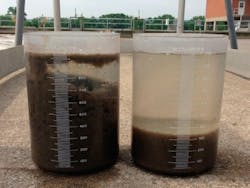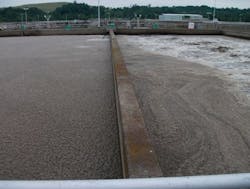Sanitaire® Fine Bubble Diffused Aeration in Montgomery County, OH
Montgomery County Environmental Services (MCES) manages water and wastewater services for the cities surrounding Dayton, Ohio, and currently serves a population of 537,602 residents. The Water Reclamation Division of MCES operates two facilities – the Western Regional Water Reclamation Facility and the Eastern Regional Water Reclamation Facility.
Project Background
With a thriving agricultural economy and growing population, the Water Reclamation Division is always looking for ways to optimize operating efficiency within their plants, said Water Reclamation Manager, Mark Livengood. An opportunity arose when the Western Regional Water Reclamation Facility began having issues with their aging jet aeration system.
Making up a football-field sized portion of the WRWR plant are eight 600,000 gallon side-by-side wastewater aeration tanks utilizing jet aeration systems. Each of the tanks contains jet aeration manifolds made of reinforced fiberglass. After 35 years of use the fiberglass deteriorated, rendering four of eight tanks inoperable.
“Efforts made to repair the cracks were unsuccessful, and the failing jet aeration system led to inadequate oxygen supply.”
The low oxygen resulted in effluent ammonia concentrations exceeding the levels allowed in the effluent permit. Livengood said the site was left with no other option but to replace the aging jet aeration system.
Solution
Montgomery County recognized an opportunity to increase their plant’s efficiency by utilizing a fine bubble diffused aeration system. Fine bubble diffused aeration systems produce smaller bubbles that have a larger surface area and longer residence time in the water being treated. They also eliminate the need for the pumps that are required as part of the jet aeration system, further improving efficiency. The result is higher oxygen transfer efficiency-- the higher the oxygen transfer efficiency, the lower the power cost to operate the system.
The Western Regional Water Reclamation Facility purchased the Xylem/Sanitaire® Silver Series Membrane Disc fine bubble diffused aeration system because of the product’s reputation for being reliable and energy efficient.
Result
Within 72 hours of starting up the new aeration system, Livengood said plant managers saw benefits of the new product. The settling velocity of the sludge had visibly improved and the fine bubble diffused aeration system achieved superior ammonia removal with less air being injected into the tank.
After only three months of successful run time, Montgomery County experienced significant energy and cost savings operating only the fine bubble diffused aeration systems. They predict even more savings in the future when the plant is fully converted to fine bubble diffused aeration.
“We have identified cost reduction…will equate to an estimated $111,500 in annual energy savings. In addition, two mixing pumps required for the jet aeration system will be taken off-line, equating to an additional $68,600 in annual energy savings.”
Livengood added, the new Sanitaire® system works with existing blowers and motors, enabling the plant to realize a cost savings by a significant reduction in air demand. Additionally, the system has been designed to allow for additional diffusers to be added or removed in case the facility must meet new nutrient removal limitations.
Editor's Note: Scranton Gillette Communications and the SGC Water Group are not liable for the accuracy, efficacy and validity of the claims made in this piece. The views expressed in this content do not reflect the position of the editorial teams of Water & Wastes Digest, Water Quality Products and Storm Water Solutions.

